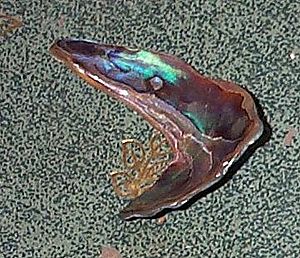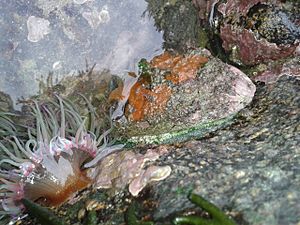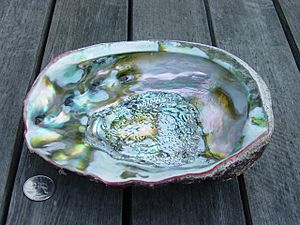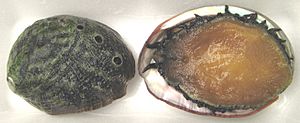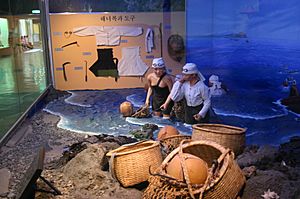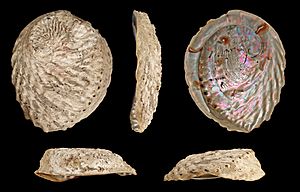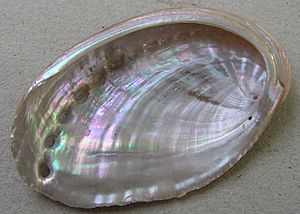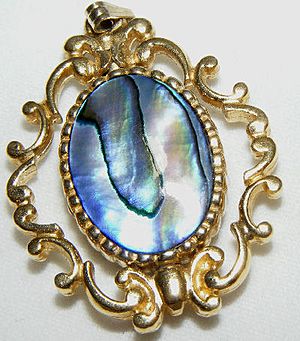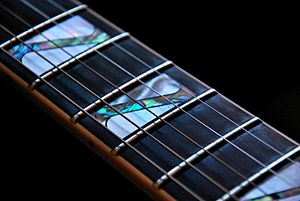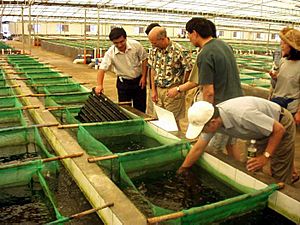Abalone facts for kids
Quick facts for kids Abalone |
|
|---|---|
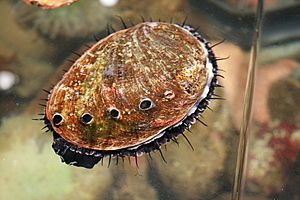 |
|
| A living abalone | |
| Scientific classification | |
| Kingdom: | |
| Phylum: | |
| Class: | |
| Subclass: |
Vetigastropoda
|
| Superfamily: |
Haliotoidea
|
| Family: |
Haliotidae
Rafinesque, 1815
|
| Genus: |
Haliotis
Linnaeus, 1758
|
Abalone (from Spanish Abulón) are a type of Gastropod shellfish.
Abalone are known by their colorful inside shell. This is also called ear-shell in Guernsey, perlemoen in South Africa, and pāua in New Zealand.
The meat of this shellfish is thought to be delicious in some parts of Latin America (especially Chile), South East Asia, and East Asia (especially in China, Japan, and Korea).
Contents
Description
Abalones live all over the world. They can be seen along the waters of every continent, except the Atlantic coast of South America, the Caribbean, and the East Coast of the United States. Most abalones are found in cold waters, along the coasts of New Zealand, South Africa and Australia, and Western North America and Japan in the Northern Hemisphere.
In the Chilean Pacific coast, the species called loco has a hard, black shell, and is eaten by many people.
Abalone have unique features: the shell is round, with two to three spirals. The last spiral is grown into a large "ear"-like shape, which explains the name 'ear-shell'. The inside of the shell is shiny, from silvery white to green-red mother-of-pearl.
Abalones can start to give birth at a small size. Their fertility is high and increases with size (from 10,000 to 11 million eggs at a time).
Young albalones, called larvae, feed on plankton. The adults eat plants and feed on algae. They like to eat red algae. Their size can be as small as 20 mm to as big as 200 mm.
The shell of the abalone is known for being very strong. It is made of very tiny calcium carbonate tiles stacked like bricks. Between the layers of tiles is a sticky protein substance.
Allergic skin reactions and asthma attacks can happen when breathing the dust made when these tiles are broken down.
The colorful inside part of the abalone shell can be used for decorative inlays, in guitars, for example.
Harvesting
Australia
Tasmania supplies about 25% of the yearly world abalone harvest. Around 12,500 Tasmanians recreationally fish for blacklip and greenlip abalone.
United States
Sport harvesting of red abalone is permitted with a California fishing license and an abalone stamp card.
As of 2017, Abalone season is May to October, excluding July. Transportation of abalone may only legally occur while the abalone is still attached in the shell. Sale of sport-obtained abalone is illegal, including the shell. Only red abalone may be taken, as black, white, pink, flat, green, and pinto abalone are protected by law.
An abalone diver is normally equipped with a thick wetsuit, including a hood, bootees, and gloves, and usually also a mask, snorkel, weight belt, abalone iron, and abalone gauge.
Alternatively, the rock picker can feel underneath rocks at low tides for abalone. Abalone are mostly taken in depths from a few inches up to 10 m (33 ft); less common are freedivers who can work deeper than 10 m (33 ft).
Abalone are normally found on rocks near food sources such as kelp. An abalone iron is used to pry the abalone from the rock before it has time to fully clamp down. Divers dive from boats, kayaks, tube floats, or directly off the shore.
New Zealand
In New Zealand, abalone is called pāua from the Māori language). 'Blackfoot pāua is found in New Zealand, the highly polished shell is extremely popular as souvenirs with its striking blue, green, and purple iridescence.
Like all New Zealand shellfish, recreational harvesting of pāua does not require a permit, provided catch limits, size restrictions, and seasonal and local restrictions set by the Ministry for Primary Industries (MPI) are followed.
South Africa
The largest abalone in South Africa, Haliotis midae, occurs along roughly two-thirds of the country’s coastline.
Abalone-diving has been a recreational activity for many years, but stocks are currently being threatened by illegal commercial harvesting. In South Africa, all persons harvesting this shellfish need permits that are issued annually, and no abalone may be harvested using scuba gear.
Channel Islands
Haliotis tuberculata are considered a delicacy in the British Channel Islands as well as in adjacent areas of France.
This, and a recent lethal bacterial disease, has led to a dramatic depletion in numbers since the latter half of the 19th century, and it is now strictly regulated in order to preserve stocks.
Decorative items
The highly iridescent inner layer of the shell of abalone has traditionally been used as a decorative item, in jewelry, buttons, and as inlay in furniture and in musical instruments such as guitars, etc.
Abalone pearl jewelry is very popular in New Zealand and Australia, in no minor part due to the marketing and farming efforts of pearl companies.
Unlike the Oriental Natural, the Akoya pearl, and the South Sea and Tahitian cultured pearls, abalone pearls are not judged by their roundness. The inner shell of the abalone is an iridescent swirl of intense colours, ranging from deep cobalt blue and peacock green to purples, creams and pinks. Therefore, each pearl, natural or cultured, will have its own unique collage of colours.
Native use
Abalone has been an important staple in native cultures around the world, specifically in Africa and on the North American West coast. The meat was used as food, and the shell was used as currency for many tribes.
Farming
There have been a number of attempts to artificially grow (farm) abalone for the purpose of consumption.
Images for kids
-
Multi-Species Fish and Invertebrate Breeding and Hatchery, (Oceanographic Marine Laboratory, Lucap, Alaminos, Pangasinan, Philippines, 2011)
-
Haida carving with rectangular abalone shell accents
-
Abalones with asparagus
-
Abalone Hoe
-
Abalone with mandarin orange peels.
-
Abalone (dish) - in Macau
-
The black abalone, Haliotis cracherodii
-
The white abalone, Haliotis sorenseni
See also
 In Spanish: Bào yú para niños
In Spanish: Bào yú para niños


